If you’re running a complex compliance program, you’ve probably heard of SAP GRC.
It’s a heavyweight in governance, risk, and compliance software, trusted by enterprises to centralize risk oversight, manage controls, and keep regulators happy.
But in 2026, many teams are asking the same question: Is SAP GRC still the best fit for us?
For fast-moving companies, or those looking for more modern, user-friendly, or cost-effective solutions, there’s now a growing list of competitors that deliver similar (or better) capabilities without the complexity.
In this guide, I’ve rounded up the 10 best SAP GRC alternatives - from flexible no-code platforms to enterprise-grade compliance suites - so you can compare features, pricing, and fit.
Whether your priority is risk management, audit automation, ESG tracking, or all of the above, you’ll find an option that meets your needs.
TL;DR
- SmartSuite is the best overall SAP GRC alternative for 2026, combining no-code flexibility, real-time collaboration, and a fully unified GRC platform that covers policy, risk, incident, vendor, and compliance management in one place.
- MetricStream, LogicGate, and OneTrust shine for enterprises seeking deep GRC functionality, modular flexibility, or privacy-first compliance with emerging AI governance capabilities.
- AuditBoard, Diligent, and ZenGRC lead in audit automation, board governance, and AI-driven control assessments, offering specialized strengths for complex compliance programs.
- Vanta, Hyperproof, and Resolver stand out for security compliance automation, collaborative project management, and risk intelligence—each delivering tailored solutions for different compliance needs.
Let’s explore which platforms are leading the way in 2026.
Why look for SAP alternatives for GRC?
SAP GRC certainly gets several core governance, risk, and compliance fundamentals right, such as:
- Deep integration with SAP systems. SAP GRC embeds directly into various SAP applications, leveraging existing user roles, authorizations, and transactional data. This native approach delivers synchronized control structures and accurate enforcement of permissions across the SAP landscape.
- Centralized risk and compliance visibility. By consolidating data from multiple domains (e.g., audits, controls, risks, and access), SAP GRC provides a unified, real-time view of governance posture. Organizations benefit from comprehensive documentation, audit-ready reporting, and strategic oversight.
Still, there are several reasons why teams consider an alternative:
1. Too SAP-focused
This comes as no surprise, as SAP GRC is, after all, an integral part of SAP’s suite.
As a result, SAP GRC is the perfect choice for organizations which have already implemented other SAP products in their workflows.
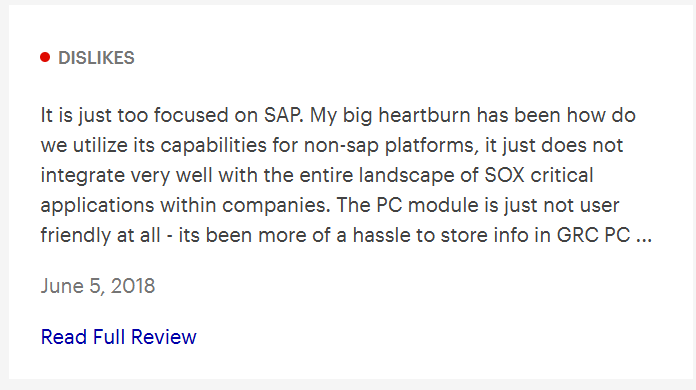
However, if you’re not an SAP user, chances are that its GRC solution will not do much for you, as it will have fairly limited use without access to other SAP products, partly because it is difficult to integrate with third-party platforms.

2. Outdated interface with limited customization options
Many users complain about SAP GRC’s interface being very outdated and clunky, making navigation harder for the average user.
As a result, you’ll be far too dependent on IT support, even for little things such as quick troubleshooting.
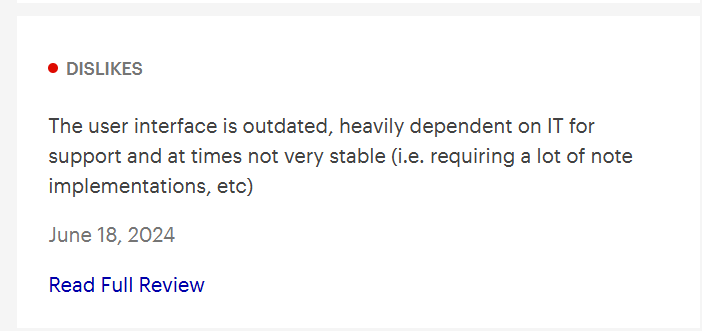
This makes for a poor combination with SAP GRC’s limited customization options, as users constantly face obstacles when trying to tailor the platform to their organization’s unique needs.

3. Its reporting features leave a lot to be desired
Finally, reporting and analytics are one of the essential functionalities of GRC software, as being able to detect and mitigate risks before they wreak havoc on your organization is critical.
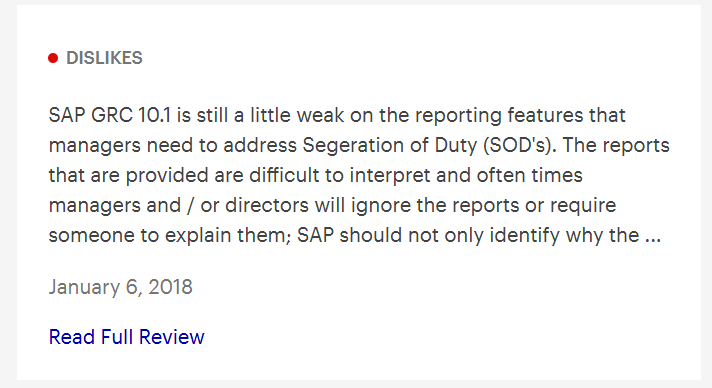
SAP GRC’s reporting is not granular or detailed enough, meaning you might be exposed to potential threats a bit more than you’d prefer.
And now, time to look at the tools that stand out as the best SAP alternatives for GRC based on their functionality, UX, and use cases.
What are the best SAP GRC alternatives and competitors in 2026?
The 10 best alternatives to SAP GRC are SmartSuite with its flexible, no-code capabilities, MetricStream, and LogicGate.
Here's a breakdown:
- SmartSuite - Best overall SAP GRC alternative for flexible, no-code governance.
- MetricStream - Best for large enterprises with complex compliance needs.
- LogicGate - Best for agile, modular GRC workflows.
- OneTrust - Best for privacy-first compliance and ESG tracking.
- AuditBoard - Best for audit, SOX, and internal controls.
- Diligent - Best for board governance and compliance.
- Vanta - Best for security compliance automation (SOC 2, ISO 27001).
- Hyperproof - Best for collaborative compliance project management.
- ZenGRC - Best for user-friendly, fast-to-deploy GRC with prebuilt frameworks.
- Resolver - Best for risk intelligence and incident tracking.
1. SmartSuite
Best for: Teams of all sizes looking for a flexible, customizable, no-code GRC platform that can easily adapt to all kinds of workflows and organizational needs.

SmartSuite is a highly customizable, no-code governance, risk, and compliance platform built for real-world teams - novices and veterans alike.
With pre-built templates, visual automation, and an intuitive interface, it lets organizations move beyond rigid, legacy GRC stacks toward dynamic, collaborative risk management.
What truly sets SmartSuite apart is its unified and flexible platform, offering cross-team GRC across policy, risk, audit, vendor, privacy, incident, continuity, and more, all under one roof with endless possibilities for customization.
Let’s take a closer look at some of its best features.
1. One platform, every GRC workflow you need
Where legacy GRC tools often silo functions into separate modules or even separate products, SmartSuite unifies your entire governance, risk, and compliance program into one interconnected workspace.
That means your policy manager, risk analyst, vendor owner, and incident responder are all working from the same data, in real-time, so there’s no more juggling disconnected systems or duplicate spreadsheets.
Here are some of the things you get with SmartSuite’s GRC module:
- End-to-end GRC in a single hub - Manage every core GRC function (e.g., contract management, incident response, third-party risk, data privacy, vulnerability management, cyber-risk compliance, etc.) without ever leaving the platform. This holistic approach ensures nothing falls through the cracks, and risk data stays consistent across all functions.
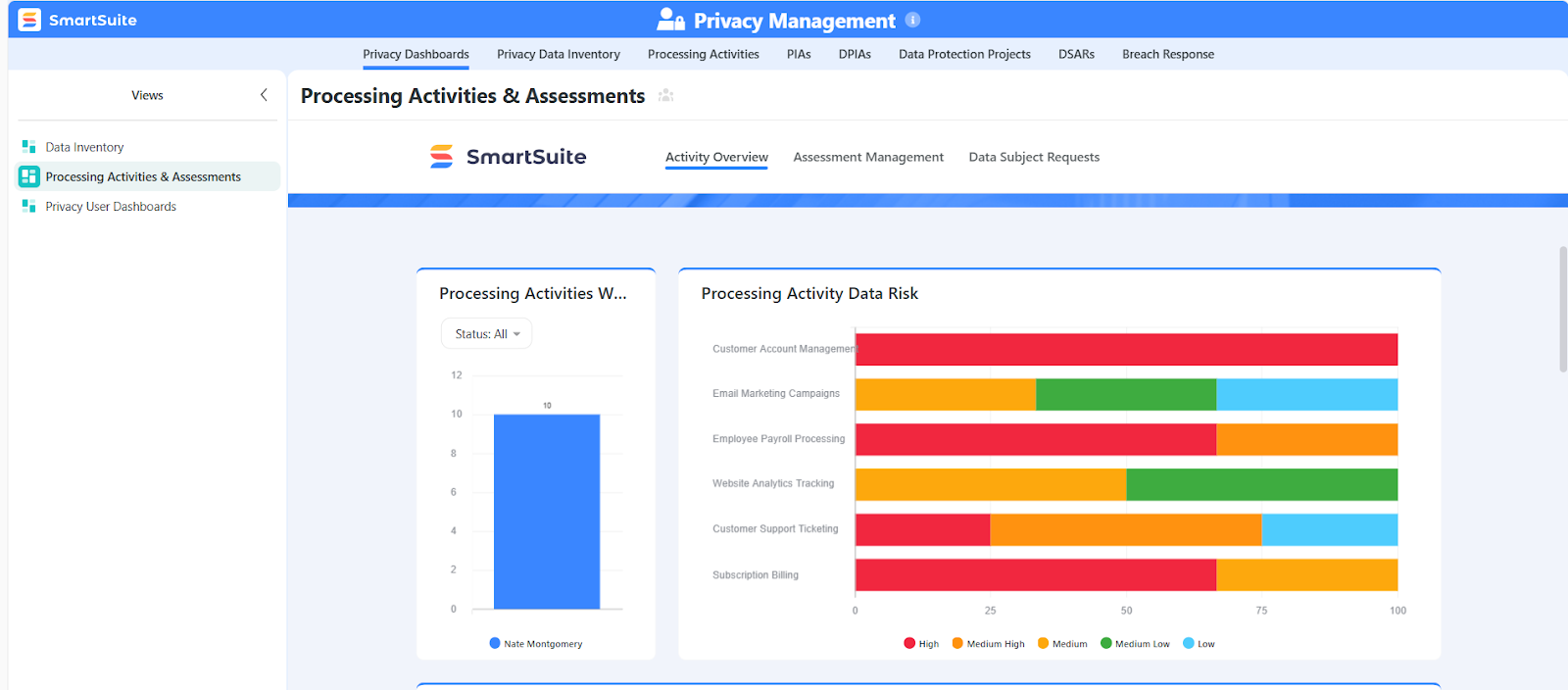
- Real-time collaboration that breaks down silos - Multiple team members can view, edit, and comment on the same records simultaneously, with changes appearing instantly across devices. Built-in activity history, mentions, and notifications keep stakeholders aligned, whether they’re in compliance, IT, legal, or operations.
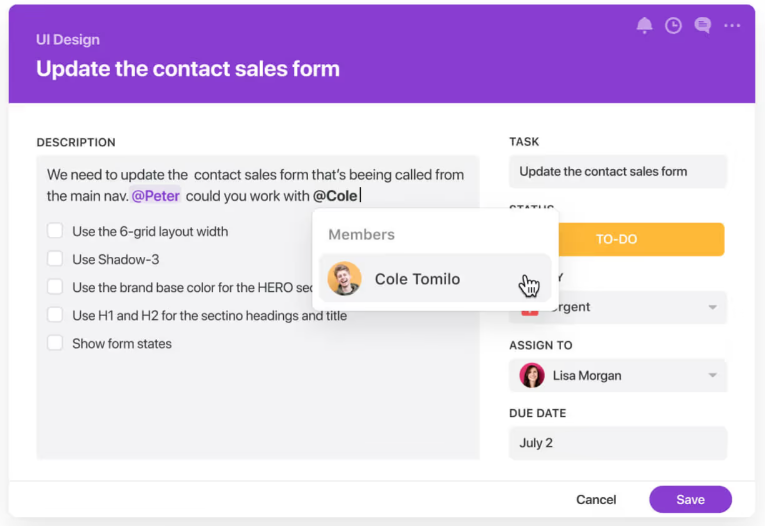
- Streamlined workflows and automation - Automate repetitive tasks like control assignments, incident escalations, and policy review reminders with the visual automation builder. This not only reduces human error but ensures your GRC processes run consistently and on schedule.
- Enterprise-grade security and access controls - Manage sensitive risk data with robust role-based permissions, ensuring the right people have the right access at the right time, which is critical for compliance with standards like ISO 27001, SOX, and GDPR.
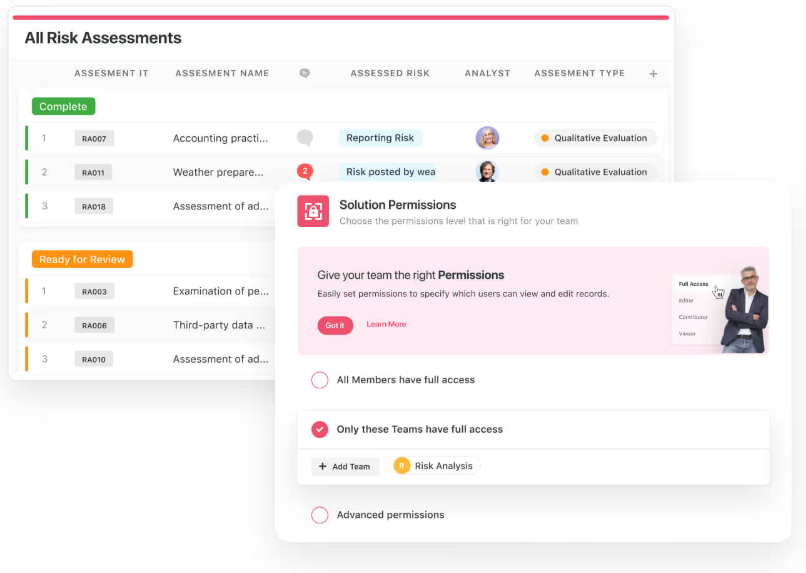
- Comprehensive risk management - Build a centralized Risk Register to identify, assess, and track organizational risks. Assign ownership, evaluate likelihood and impact, set mitigation plans, and measure control effectiveness through visual dashboards and roll-up reports, so leadership always has a clear view of your risk posture.
- Quick and efficient threat management - Centralize incident response and threat mitigation activities in one place. Prioritize and assign key tasks so the right people act at the right time, keeping potential damage to a minimum.
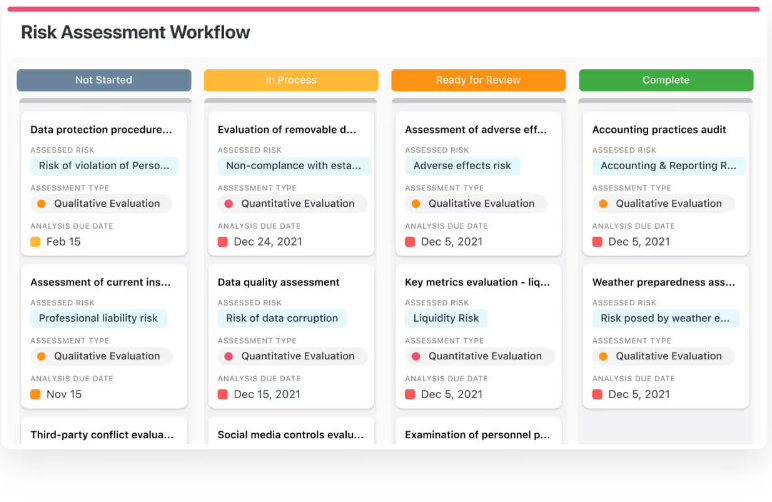
2. Robust reporting and data visualization
When it comes to GRC, data isn’t just information - it’s proof.
SmartSuite’s reporting engine turns raw risk, control, and compliance data into clear, actionable insights that stand up to board reviews, audits, and regulatory scrutiny.
Here’s how:
- Multiple ways to view your data - Switch seamlessly between Grid, Kanban, Timeline, Chart, Map, Calendar, and Card views, or pull it all together into an interactive dashboard. With a single click, you can pivot from a high-level risk overview to the granular details of an individual incident or policy.
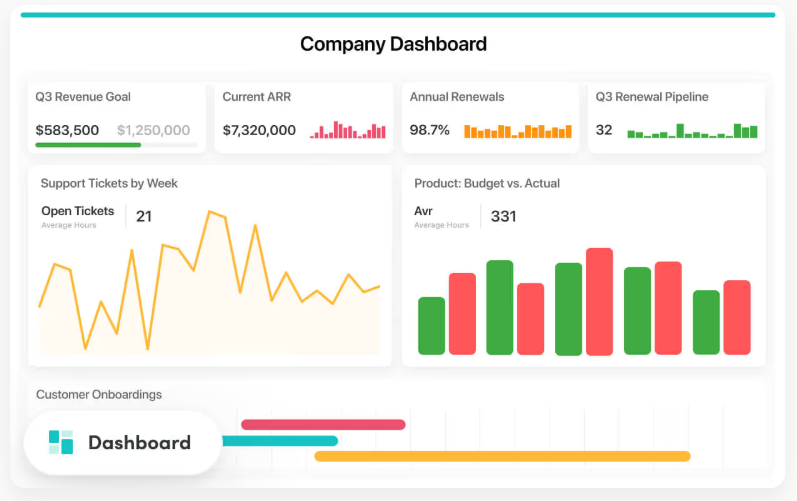
- Build reports in minutes - No complex setup, no code. Just choose your fields, apply filters, group records, and create nested sorts to organize complex data in seconds. Spotlight rules let you highlight critical values, deadlines, or anomalies so nothing gets missed.
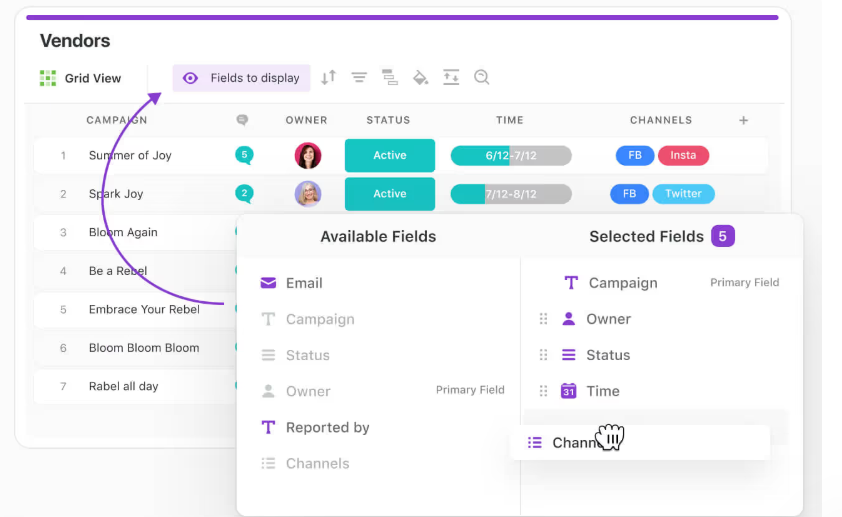
- From ad hoc to always-on reporting - Save frequently used reports and star them as favorites for quick access. Create public reports for team-wide alignment or private reports for your personal workflow. Share reports via email with deep links, or schedule automated deliveries at whatever cadence your leadership prefers.
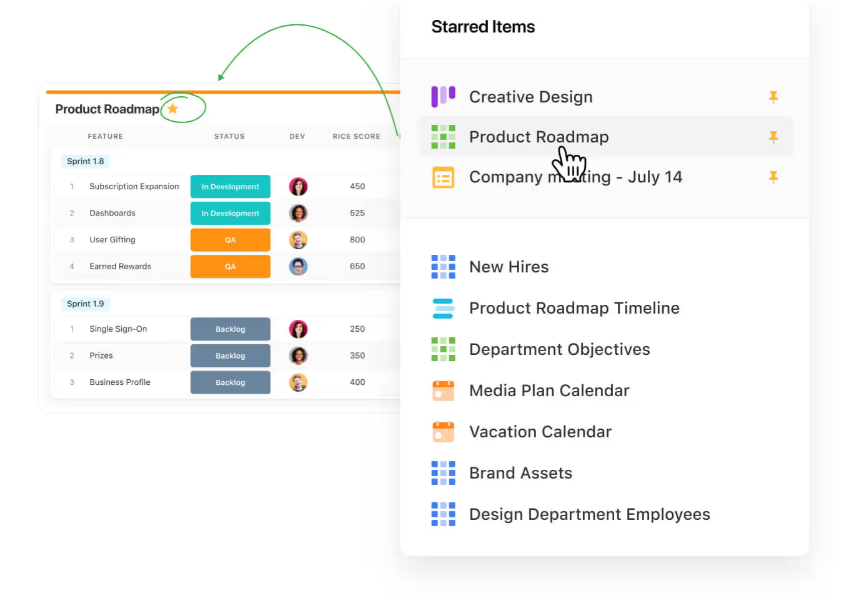
- Any format, any time - Export reports instantly to PDF, Excel, CSV, or Google Sheets for external sharing, archival, or integration into presentations. Need to print a compliance status report for a regulator? It’s a two-click process.
- On-the-go access - Whether you’re on a laptop, tablet, or phone, SmartSuite’s responsive design ensures you can access, edit, and present reports from anywhere.

- Decision-ready dashboards - Combine multiple reports into dynamic dashboards with charting, KPI widgets, and roll-up metrics, giving executives and risk owners a live, single-pane-of-glass view of your organization’s compliance health.
3. Customization and flexibility built for your organization
SmartSuite is designed to adapt to your exact processes, regulatory requirements, and reporting needs without relying on expensive custom development or IT bottlenecks.
Within SmartSuite, you get:
- To work your way - Choose from over 40 different field types, from dropdowns and multi-select lists to rich text, formulas, and calculated scores, to capture and track the data that matters most to your organization. Add, remove, or modify fields at any time as your processes evolve.
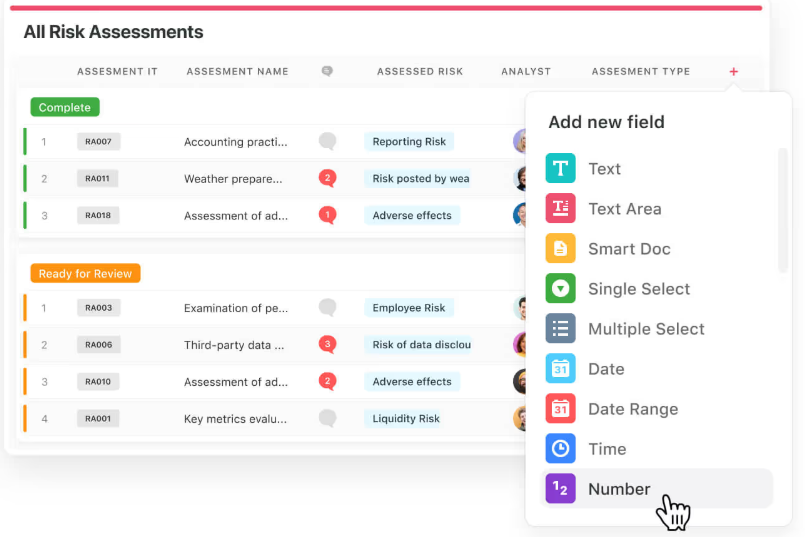
- Custom risk scoring and metrics - Define your own risk calculations, KPIs, and leading indicators. Whether you want a single composite risk score or multi-factor metrics with weighted inputs, SmartSuite’s calculation capabilities make it easy to measure what’s most important for your governance strategy.
- Dashboards that reflect your priorities - Build intuitive, role-specific dashboards that surface the most relevant reports, charts, and KPIs for each stakeholder group, so executives, compliance officers, and operational teams all get the context they need at a glance.

- Integrations that keep everything connected - Consolidate your compliance data without disrupting existing systems. SmartSuite connects natively with leading tools, supports Zapier for thousands of integration possibilities, and offers a robust REST API for direct system-to-system communication.
- Change without disruption - Need to add a new workflow for an emerging regulation? Update a control testing process? Introduce a new report for the board? SmartSuite’s no-code configuration means you can make adjustments in minutes instead of weeks, so your GRC framework stays responsive to new risks and regulations.
4. Ready-made templates to launch faster
One of the biggest hurdles in GRC implementation is the setup time, as months can pass before teams have a usable system.
SmartSuite removes that barrier with a library of ready-to-use, fully customizable solution templates designed by industry experts.

The best part? These aren’t static forms. They’re live, interactive workflows preloaded with best practices, so you can go from zero to operational in days.
Here are just a few you can start with:
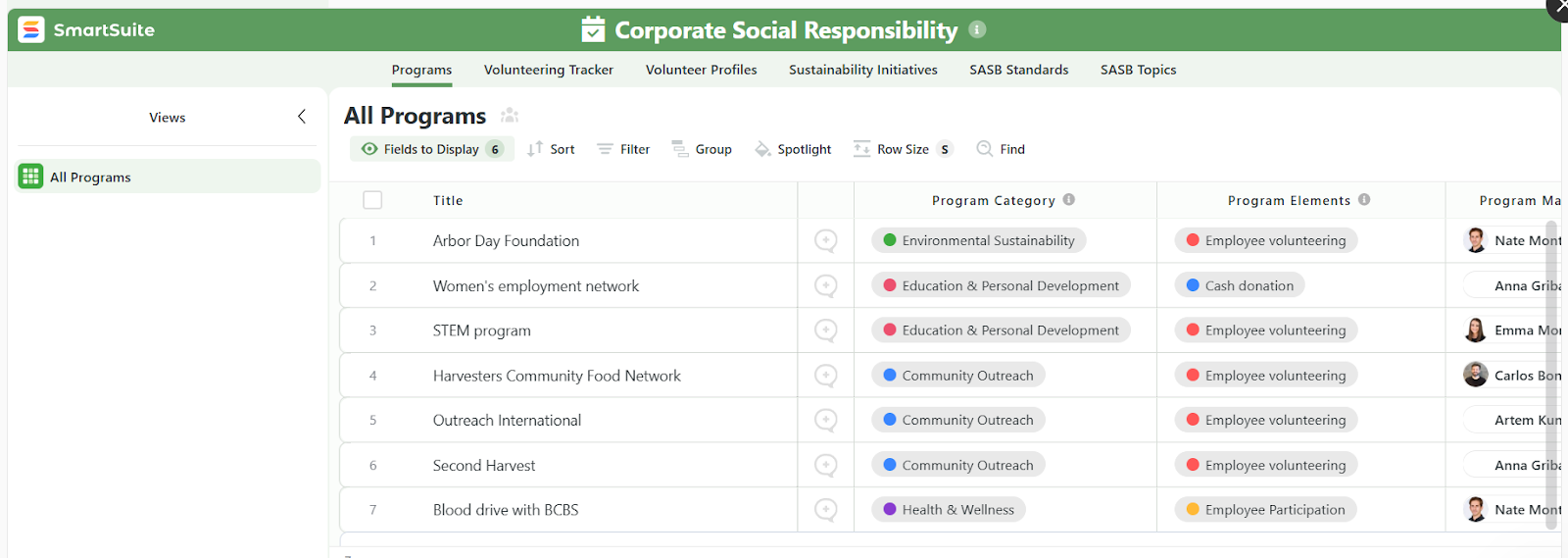
- Audit Planning - Plan, track, and execute internal and external audits with confidence. Assign responsibilities, document findings, and link evidence directly to controls, creating a seamless audit trail that’s ready for regulators at a moment’s notice.
- Regulatory Change Management - Stay ahead of shifting laws and frameworks. This template tracks regulatory updates, maps them to your policies and controls, and manages remediation tasks, helping your organization maintain continuous compliance.
- Corporate Social Responsibility - Monitor initiatives like carbon credit tracking, ethical sourcing, and diversity metrics. Link CSR data to governance goals to align sustainability with compliance efforts.
- IT Asset Management - Manage the full lifecycle of your hardware, software licenses, and cloud resources. Keep assets linked to related risks, incidents, and vendor records for complete visibility.
- Vulnerability Management - Identify, prioritize, and remediate security vulnerabilities. Automate alerts for critical findings, track remediation progress, and generate reports to demonstrate risk reduction over time.
Play around with one of SmartSuite’s templates to get a hang of how intuitive and interactive they are.
Pricing
SmartSuite’s pricing is simple and transparent.
The platform has a free forever plan that provides access to its templates, dynamic dashboards, team collaboration features, 100 monthly automations, etc, making it ideal for small teams testing the waters.
And if you need more features, you can subscribe to one of four paid plans:
- Team: $12/user/mo, includes everything in Free, plus unlimited users, Gantt charts, 5,000 automation runs, etc.
- Professional: $30/user/mo, includes everything in Team, plus two-factor authentication, Gmail & Outlook integrations, AI features, more automation runs, etc.
- Enterprise: $45/user/mo, includes everything in Professional and adds audit logs, data loss prevention, 50,000 monthly API calls, etc.
- Signature: A customized plan tailored to your organization’s needs and team size with no predefined limits.

The first three paid plans have a 14-day free trial - no credit card needed.
How Does SmartSuite Compare to SAP GRC?
SAP GRC has long been the go-to choice for enterprises already invested in the SAP ecosystem.
Its deep integration with SAP ERP/S/4HANA and strong access governance make it a natural fit for large, SAP-centric organizations.
But for companies seeking more flexibility, faster deployment, and broader integrations, SmartSuite offers a compelling modern alternative.
Here’s how they stack up:
- Ease of use & UI - While SAP GRC is powerful, its interface is often described as dated and complex, requiring extensive training and IT involvement. SmartSuite delivers a clean, intuitive UI designed for both technical and non-technical users, so teams can hit the ground running without weeks of onboarding.
- Flexibility & customization - SAP GRC’s customization is possible but typically requires specialist support. SmartSuite offers over 40 field types, no-code workflows, and instantly adjustable dashboards, letting you adapt processes, reports, and risk scoring in minutes.
- Reporting power - SAP GRC’s reporting is functional but limited in visualization and ad-hoc analytics. SmartSuite lets you build detailed, interactive reports in Grid, Kanban, Timeline, Chart, Map, and Dashboard views, exportable in multiple formats and accessible on any device.
- Integration breadth - SAP GRC excels in SAP-to-SAP connections but is less friendly to diverse tech stacks. SmartSuite offers native integrations, Zapier support, and a REST API, making it easier to connect with your existing tools.
- Deployment speed - SAP GRC implementations can take months. SmartSuite’s ready-made GRC templates, from Audit Planning to Regulatory Change Management, enable operational use within days without heavy IT lift.
- Cost & accessibility - SAP GRC’s enterprise pricing and implementation costs can be prohibitive for SMBs. SmartSuite offers a free forever plan and transparent paid tiers starting at $12/user/month, making advanced GRC accessible to teams of all sizes.
Pros & Cons
✅ Unified GRC platform with all core governance, risk, and compliance functions in one workspace.
✅ Intuitive, no-code interface, easy for both technical and non-technical users to navigate, customize, and adapt without relying on IT.
✅ Robust reporting & dashboards with multiple data views (Grid, Kanban, Timeline, Chart, Map, Calendar, Card), instant filtering, grouping, and export options.
✅ Extensive customization with over 40 field types, custom risk scoring, and adaptable workflows so the platform fits your processes, not the other way around.
✅ Real-time collaboration with simultaneous record editing, commenting, and activity tracking to keep compliance, IT, and legal teams aligned.
✅ Transparent and cost effective pricing.
❌ Limited native integrations compared to some enterprise solutions.
2. MetricStream
Best for: Large enterprises that need an integrated, enterprise-grade GRC platform spanning risk, compliance, audit, cyber/IT risk, third-party risk, and ESG.

MetricStream’s ConnectedGRC suite (BusinessGRC, CyberGRC, ESGRC) centralizes governance, risk, and compliance so risk/compliance, audit, cybersecurity, and sustainability teams work from one system of record.
It’s designed to roll up risk and control data across the organization for decision-ready insights.
Key features
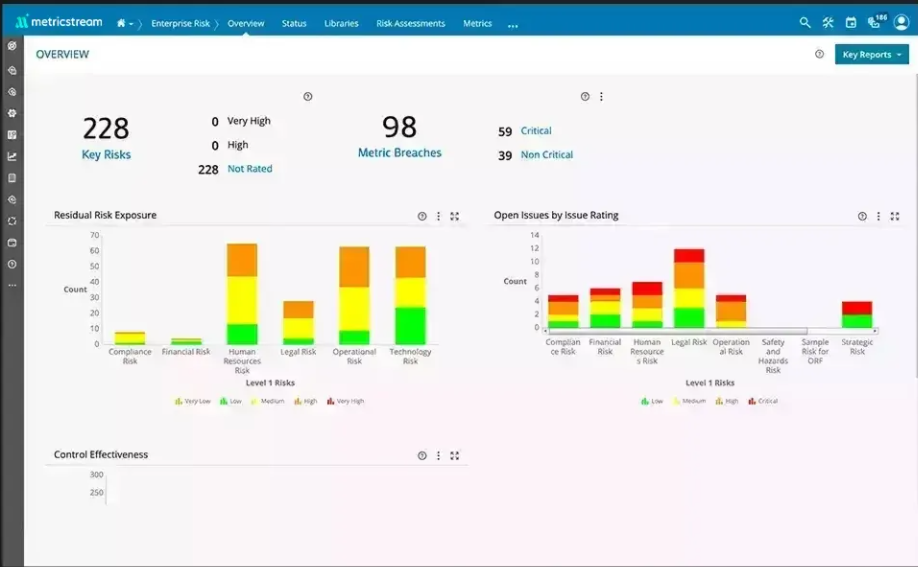
- ConnectedGRC platform - Unifies enterprise, operational, IT/cyber, third-party, compliance, audit, and ESG programs for a fully integrated GRC approach.
- Internal audit management - Accelerates audit planning, fieldwork, evidence, and reporting to shorten cycles and improve productivity.
- Continuous control monitoring & analytics - Automates evidence collection and provides dashboards/visual reports, and can also feed existing BI tools.
Pricing
MetricStream doesn’t disclose its prices, meaning you’ll have to request a quote from its team.

Or, check out our in-depth MetricStream pricing review for quick access to all the information you need.
Pros & Cons
✅ Provides unified GRC visibility for enterprise teams.
✅ Lets you build comprehensive risk heat maps across risk types and organizational departments.
❌ Difficult to use, often requires IT support to adjust critical workflows.
3. LogicGate
Best for: Organizations looking for a highly flexible, no-code GRC platform that evolves with changing business needs.
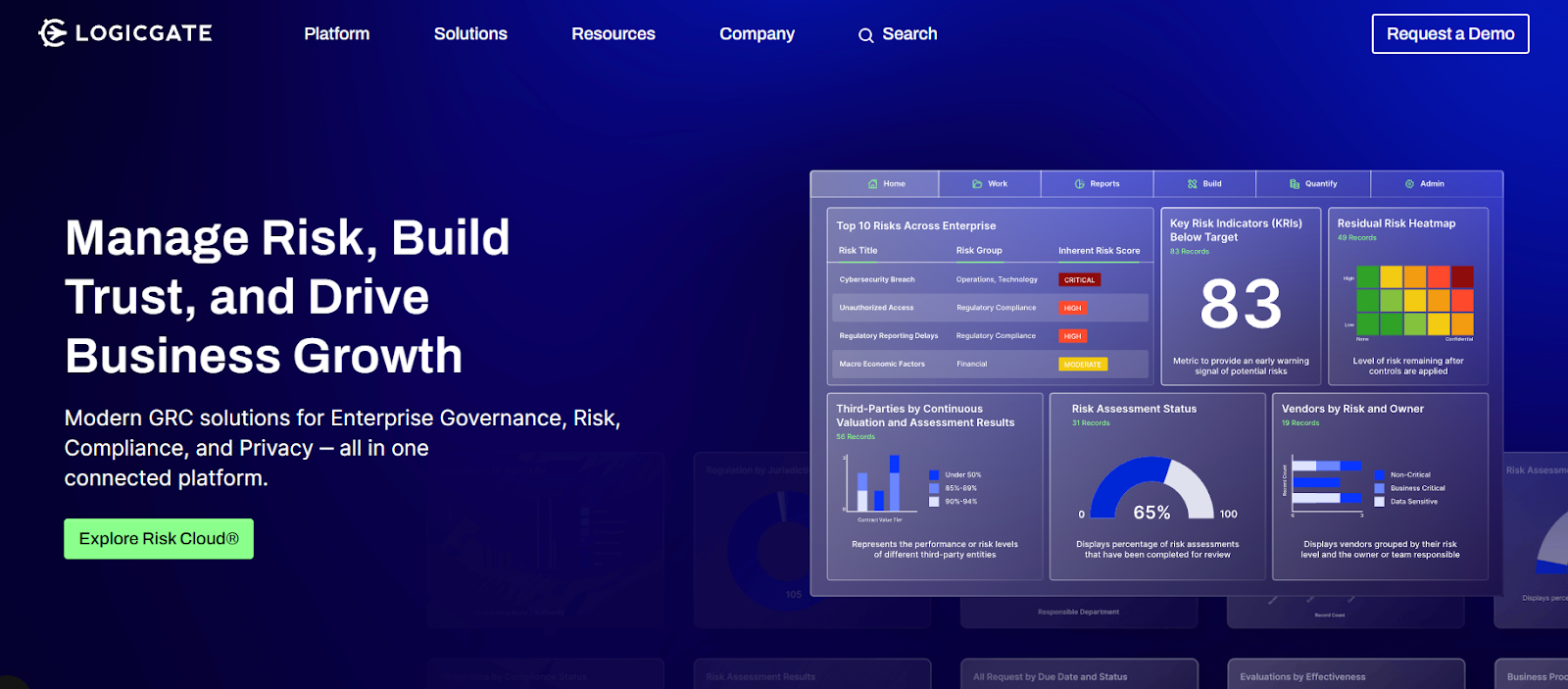
LogicGate is a no-code governance, risk, and compliance platform offering powerful customization, automation, and real-time tracking across risk, audit, compliance, and third-party workflows.
It’s designed to scale alongside evolving programs and regulatory environments, making it a good choice for agile teams.
Key features

- Custom workflow builder - Organizations can configure and deploy GRC processes quickly, with drag-and-drop workflow automation.
- Automated evidence collection & reporting - Supports electronic audit trails, real-time dashboards, and visual insights to reduce manual effort and speed decision-making.
- AI-enhanced risk quantification - Includes Spark AI capabilities and FAIR-based simulations for risk-impact analysis and faster control mapping.
Pricing
LogicGate uses a custom pricing model tailored to your organization’s size, GRC maturity, and specific use cases, so you only pay for what you need.
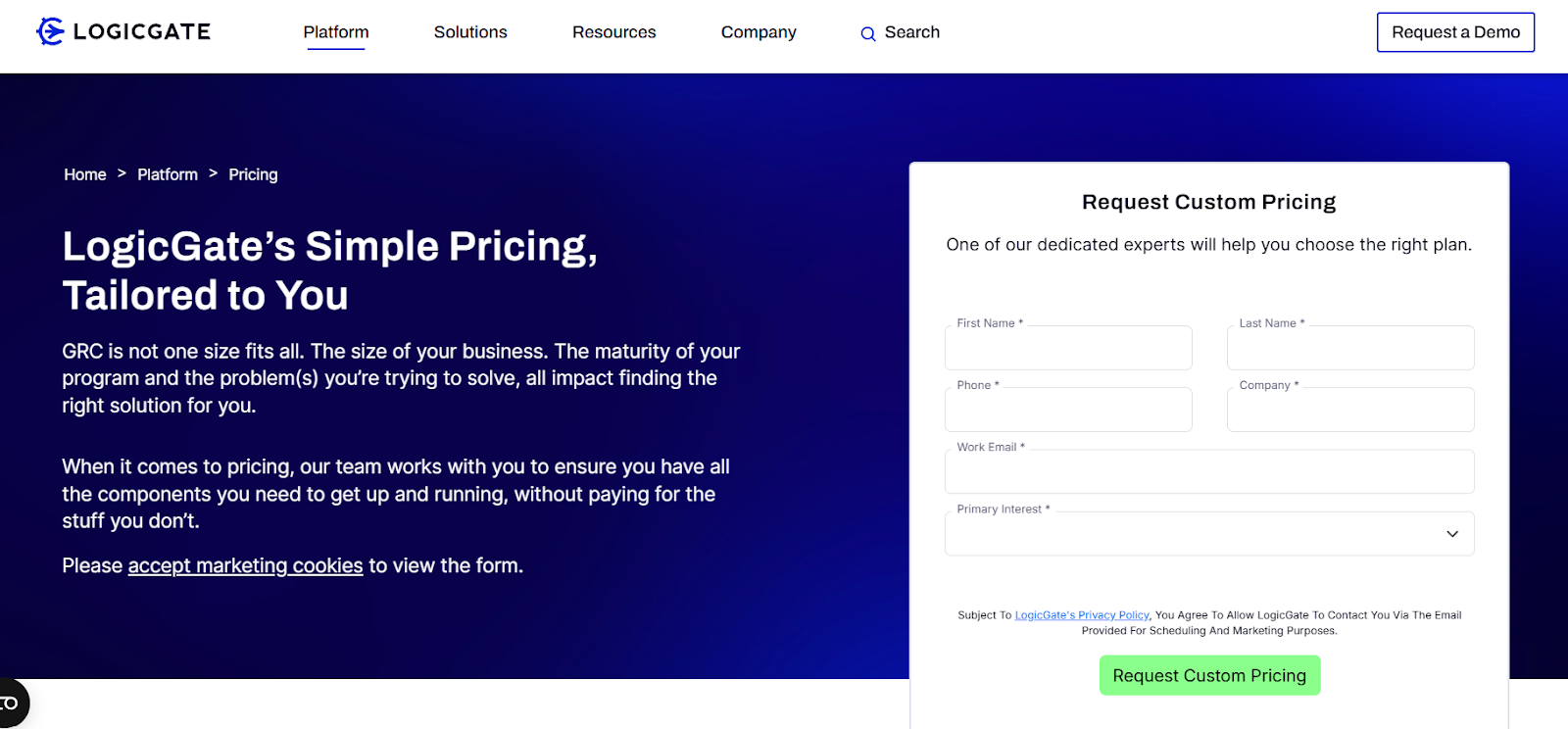
Costs are based on:
- Applications - Choose from 30+ modular GRC apps (e.g., policy management, vendor risk, incident response) and pay only for the ones you use.
- Power Users - Licenses for the people building and managing your GRC program, not your entire organization.
- Add-ons - Optional advanced features like Risk Cloud Quantify™, additional product modules, and integrations.
- Services - Implementation, professional services, and integration support available as needed.
Pricing is provided on request after a consultation with their team.
For a more detailed breakdown, check out our LogicGate’s pricing guide.
Pros & Cons
✅ Highly customizable in a no-code environment.
✅ Intuitive interface.
❌ Can lag when dealing with large datasets.
4. OneTrust
Best for: Large enterprises and global organizations that require end-to-end privacy, GRC, third-party risk, and ESG management, particularly those needing regulatory intelligence and AI-enabled automation.

OneTrust enables teams to manage data privacy, governance, risk, audit, third-party relationships, and ESG across a single interface.
With embedded AI, regulatory library, and automation, it helps organizations drive trust and scale compliance efforts all in one place.
Key features
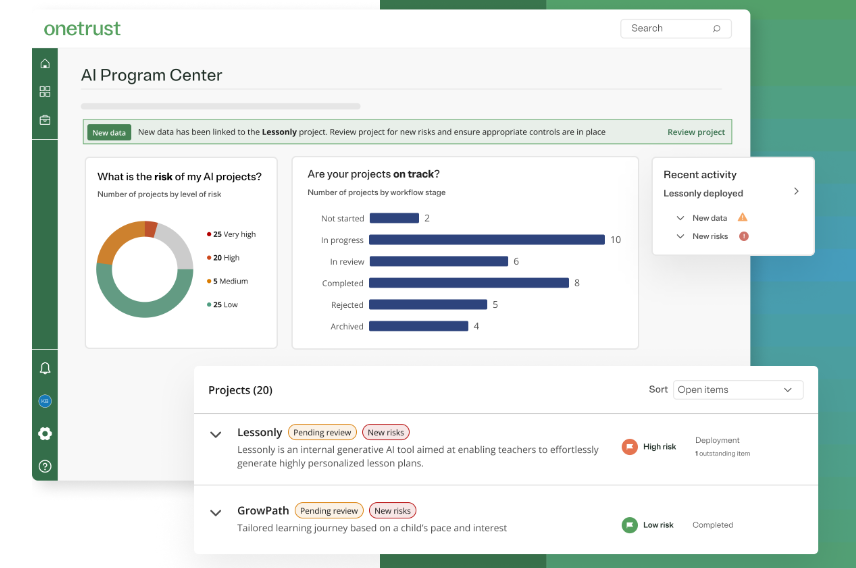
- Consent & privacy automation - Offers modular control over consent workflows, DSARs, and automated privacy operations to handle consumer data responsibly and efficiently.
- OneTrust Copilot - AI-driven chatbot that leverages NLP to help you find answers to difficult questions within your datasets.
- AI governance - Centralizes your AI program oversight with streamlined risk evaluation, automated model lifecycle monitoring, and continuous compliance mapping to frameworks like the EU AI Act, enabling responsible and compliant AI adoption.
Pricing
OneTrust has several major product packages, some of which have more than one tier:
- Consent & Preferences:
- Consent Management Platform: Pricing based on average daily visitors aggregated across all channels and properties.
- Universal Consent & Preference Management: Pricing based on total data subject profiles captured.
- Privacy Automation (Pricing based on users and privacy asset inventory for both plans):
- Base.
- Suite.
- Third-Party Risk Management (Pricing based on admin users and third-party inventory for both plans):
- Base.
- Suite.
- Tech Risk & Compliance: Pricing based on admin users and asset inventory.
- AI Governance: Pricing based on admin users and AI inventory.

There are no prices disclosed for any of the plans, so you’ll have to contact its sales team or check out our in-depth OneTrust pricing guide.
Pros & Cons
✅ Advanced reporting capabilities.
✅ Provides a unified view of all risks in a single dashboard, allowing easy navigation and quick response times.
❌ Difficult to customize.
5. AuditBoard
Best for: Large enterprises and audit-focused teams that need a powerful, integrated GRC platform tailored for audit, risk, compliance, IT risk, and ESG enriched with AI-driven insights.
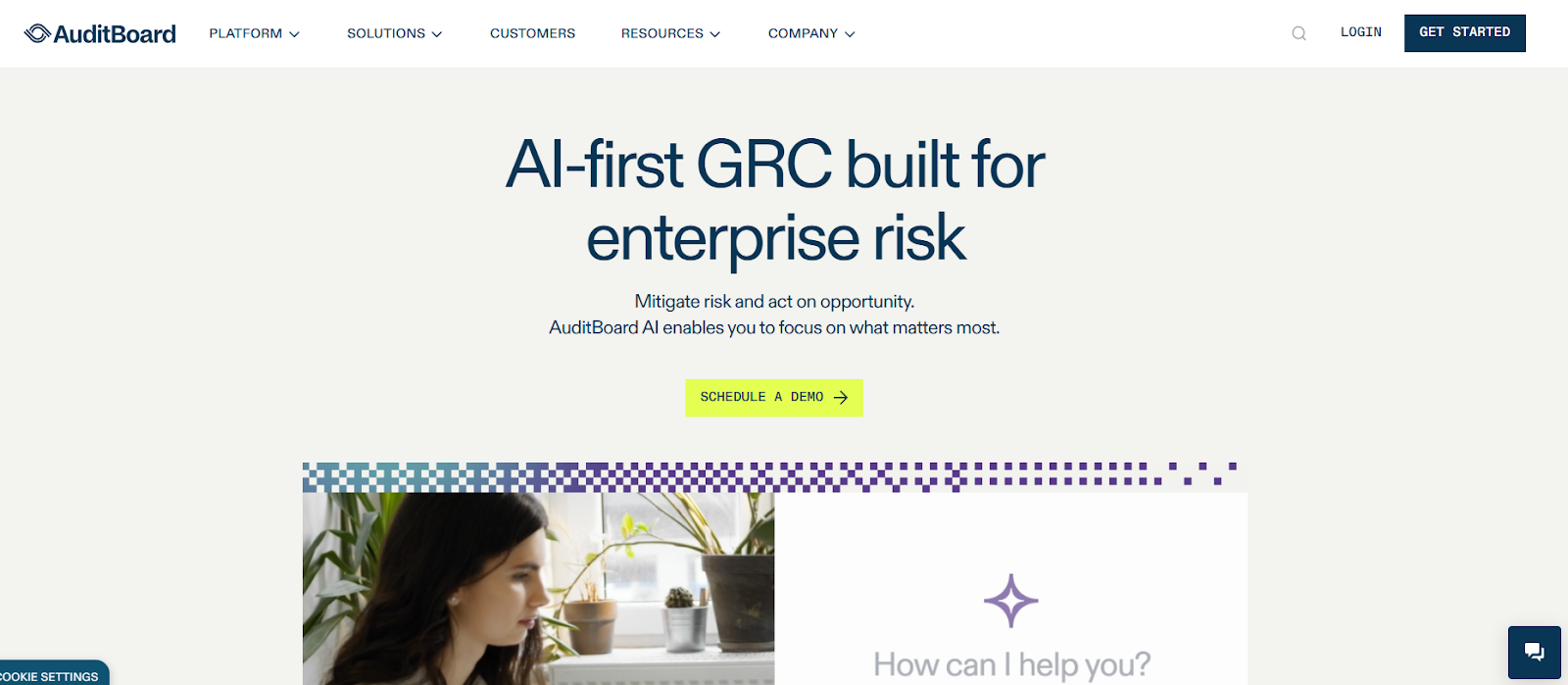
AuditBoard's Connected Risk Platform unifies modules like internal audit, risk oversight, compliance, controls management, and third-party risk management into one seamless system.
Its AI-enabled tools and integrations (e.g., ITSM, CMDB) drive efficiency, frontline ownership, and real-time visibility across your GRC ecosystem.
Key features
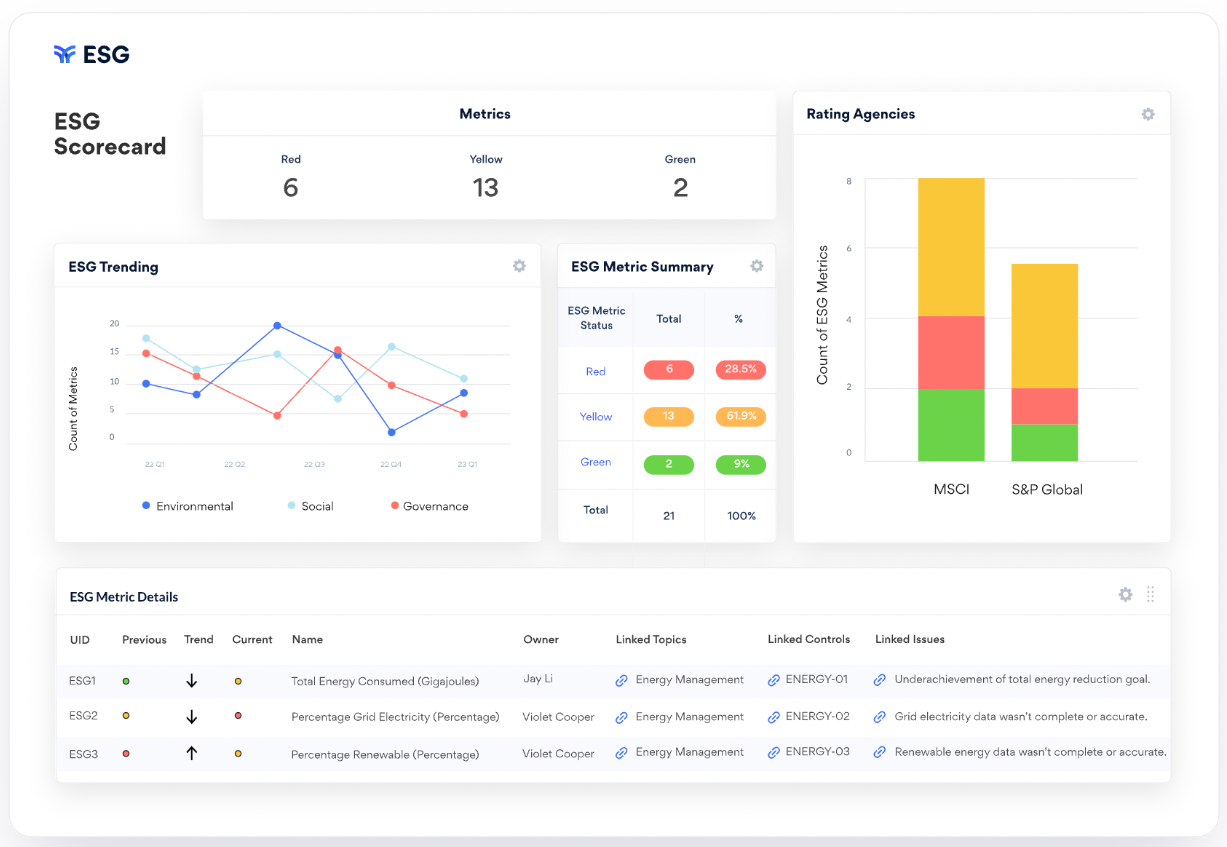
- AuditBoard AI & automation - Automates manual tasks, accelerates insights with GRC-trained AI, and creates streamlined, intelligent workflows and reports.
- Regulatory change management (RegComply) - Powered by CUBE RegPlatform, this module continuously tracks regulatory updates and maps them to adequate policies.
- No-code reporting & dashboards - Drag-and-drop reporting with real-time data visualization, preloaded frameworks (SOC 2, ISO 27001, GDPR), and customizable dashboards enable quick and granular data visualizations.
Pricing
AuditBoard doesn’t publish pricing details.
You can schedule a demo to see the platform in action and inquire about the price.

Pros & Cons
✅ Good collaboration features, allowing for easy sharing of relevant documents and workflows between team members and departments.
✅ Very user-friendly.
❌ Limited customization.
6. Diligent
Best for: Mid-to-large enterprises and audit-focused GRC teams looking for a centralized, AI-powered platform that unifies board governance, risk, audit, compliance, and controls in one system.
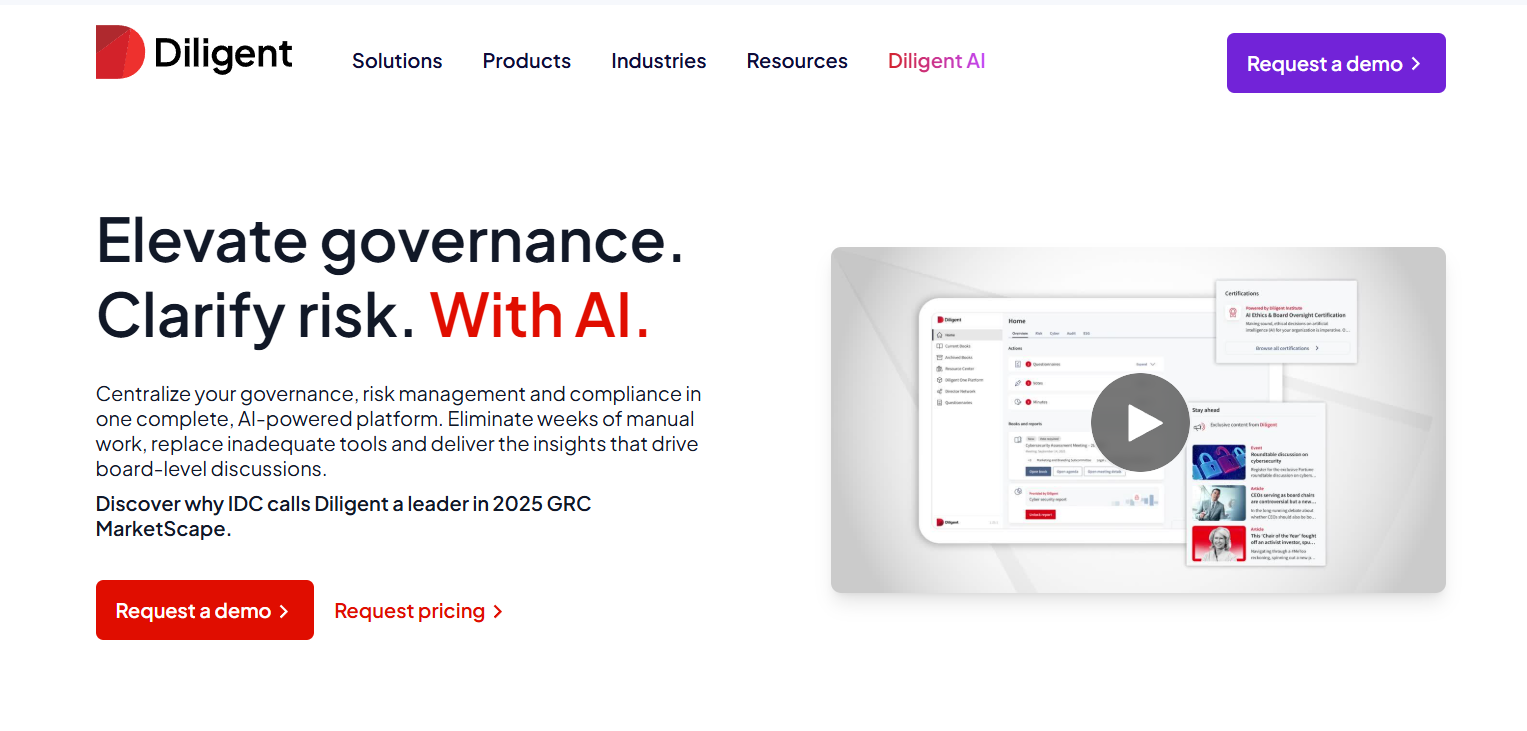
Diligent consolidates board management and full GRC activities into a single, intuitive interface.
The platform is enhanced by AI, which enables it to provide smarter risk insights, streamlined audit workflows, and governance-led reporting.
Key features

- AI-powered insights & automation - Leverages AI to reduce manual effort, surface risk trends, and optimize governance workflows.
- Robust issue management & workflow tools - Automates remediation workflows, triggers alerts, structures issue tracking, and supports risk control testing with built-in automation.
- Pre-built templates and compliance frameworks - Includes frameworks, analytics scripts, and libraries for GRC alignment, KPIs, and rapid deployment.
Pricing
There’s no official information on Diligent’s pricing plans available.
You can request a custom quote from its sales team or read our Diligent pricing review.

Pros & Cons
✅ Brings all GRC features into one centralized point of control.
✅ User-friendly interface.
❌ Issues with its real-time collaboration, as it can often lag when multiple users try working on the same report.
7. Vanta
Best for: Fast-growing companies, especially SaaS and tech firms, that need automated security compliance for frameworks like SOC 2, ISO 27001, HIPAA, and GDPR, with continuous monitoring and audit readiness.
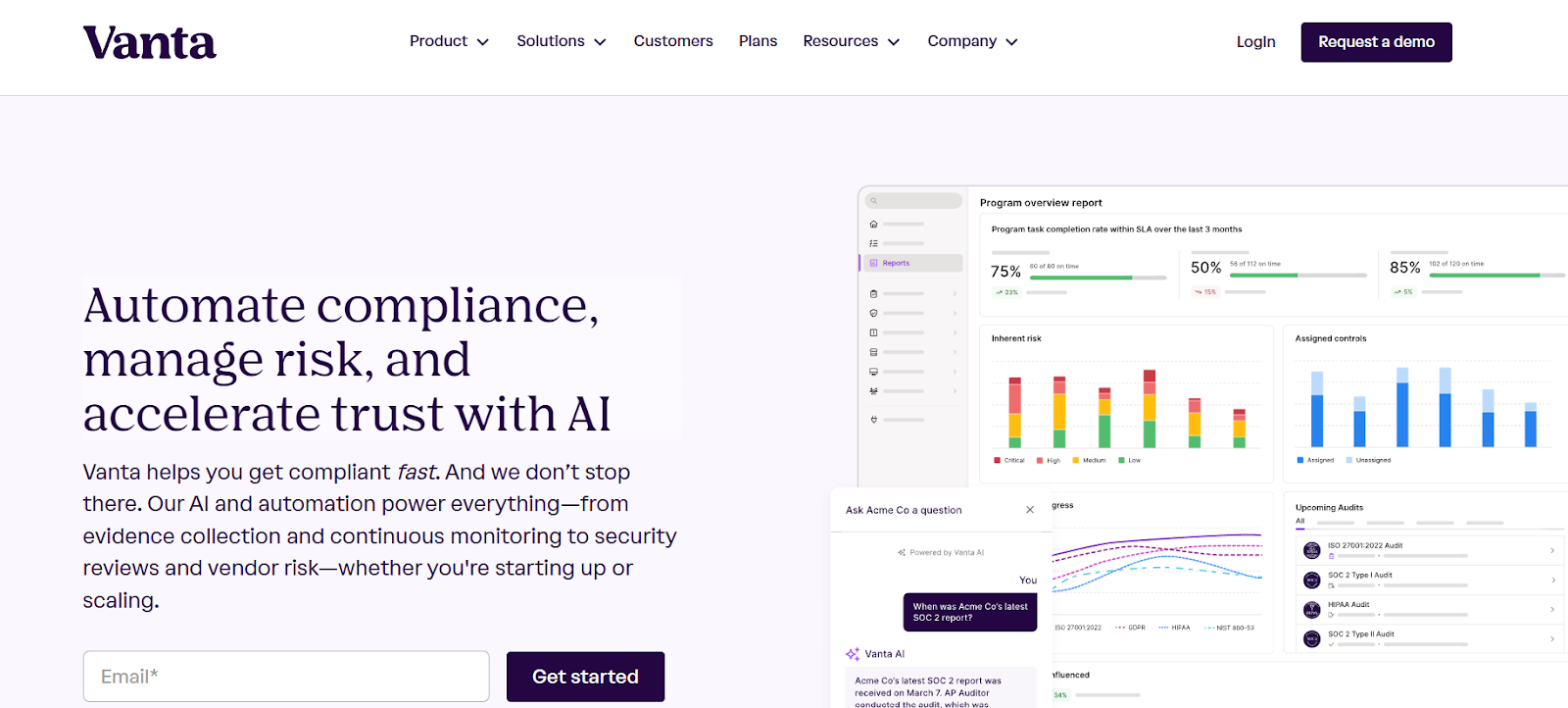
Vanta is a security and compliance automation platform that helps organizations build trust and streamline audits.
By integrating with your tech stack, it continuously monitors systems for compliance gaps, automates evidence collection, and prepares teams for certifications.
Key features
- Automated compliance monitoring - Continuously scans connected systems, cloud infrastructure, and tools to ensure controls remain in place, alerting teams to issues in real-time.
- Framework support - Prebuilt content and workflows for SOC 2, ISO 27001, HIPAA, GDPR, PCI DSS, and more, with auditor-approved evidence collection.
- Vendor risk management - Automates vendor onboarding, due diligence, and periodic reassessments with questionnaires and tracking.
Pricing
Vanta doesn’t publicly list its pricing, but it offers tiered plans tailored to startups, growing GRC teams, and large enterprises, each with increasing levels of automation, customization, and AI-powered functionality.
If you're just getting started, you can choose from two plans:
- Core: Ideal for startups seeking first-time SOC 2 or ISO 27001 compliance. Includes one framework, easy-to-scope controls, AI-powered remediation, a step-by-step policy builder, a customer-facing Trust Center, and chat support with compliance experts.
- Plus: Includes everything in Core, plus Questionnaire Automation (25/year), Access Reviews, and Access Requests, making it great for fast-moving teams with external stakeholders.

For growing and mature compliance teams, Vanta offers three plans:
- Growth: Designed for scaling GRC teams. Includes continuous monitoring, risk and asset management, 144 questionnaire automations/year, vendor inventory, the advanced Trust Center, Vanta API, issue management, and role-based access.
- Scale: Built for mature orgs needing deeper customization and automation. Adds Report Center customization, 288 questionnaire automations/year, SCIM, and multi-workspace support.
- Enterprise: A custom plan tailored to complex GRC environments. Includes advanced support, bespoke configurations, and dedicated implementation help from Vanta’s team of GRC experts.

Each plan also supports optional add-ons like Vendor Risk Management and Customer Trust Management to further streamline due diligence, evidence sharing, and inbound security reviews.

If you want the full breakdown, read our complete guide to Vanta’s pricing.
Pros & Cons
✅ Robust, AI-powered automation capabilities.
✅ Integrates with a wide range of platforms across sectors.
❌ Can be too rigid for organizations with non-standard tech stacks or unique, custom security controls.
8. Hyperproof
Best for: Mid-sized and fast-moving organizations that want a comprehensive and intuitive GRC platform with strong automation, integrations, and customer support.
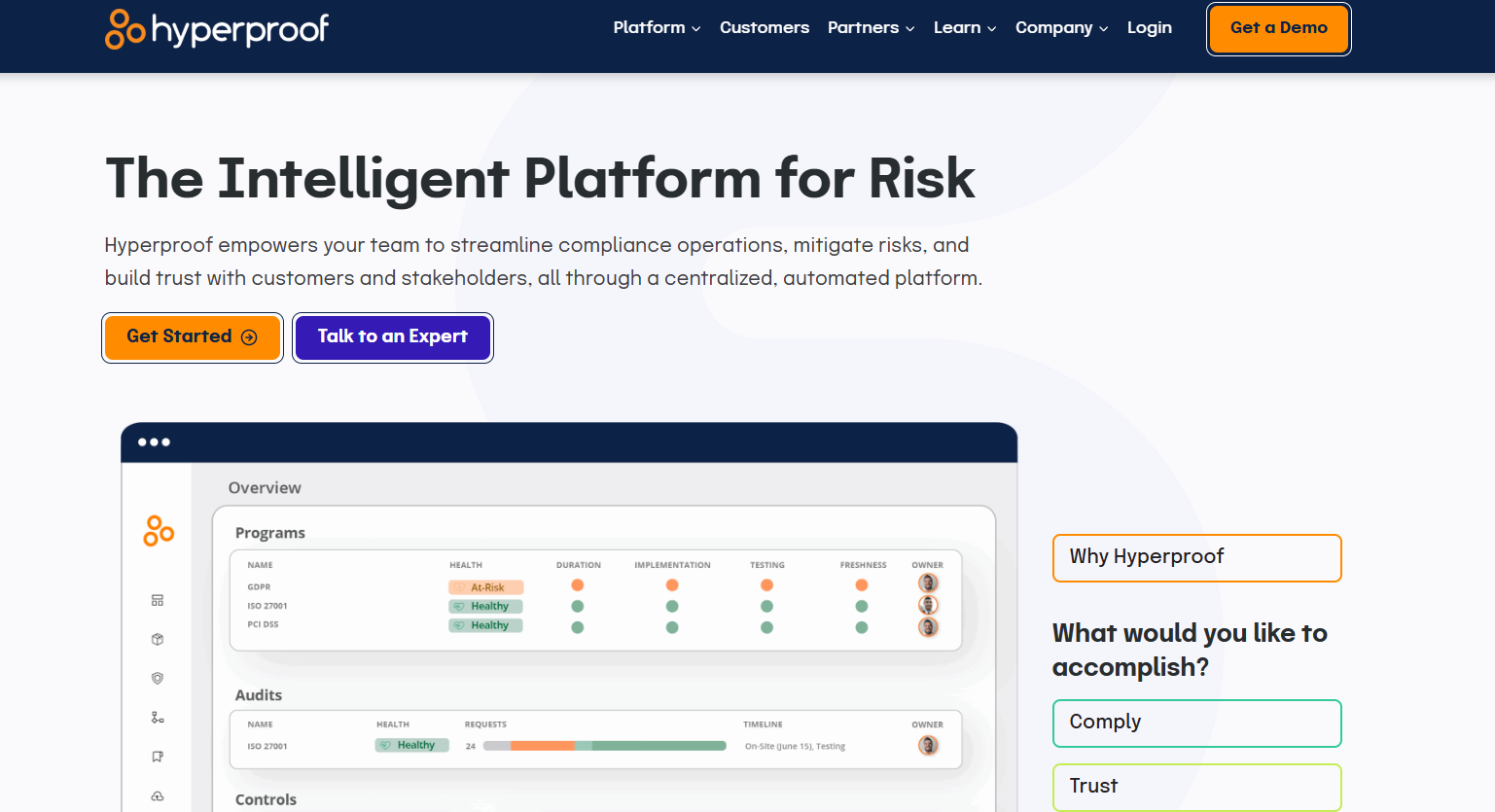
Hyperproof delivers a modern cloud-based compliance operations platform that centralizes controls, audit evidence, risk, and vendor workflows.
It’s built for continuous compliance and helps teams reduce manual work, keeping processes organized and audit-ready.
Key features
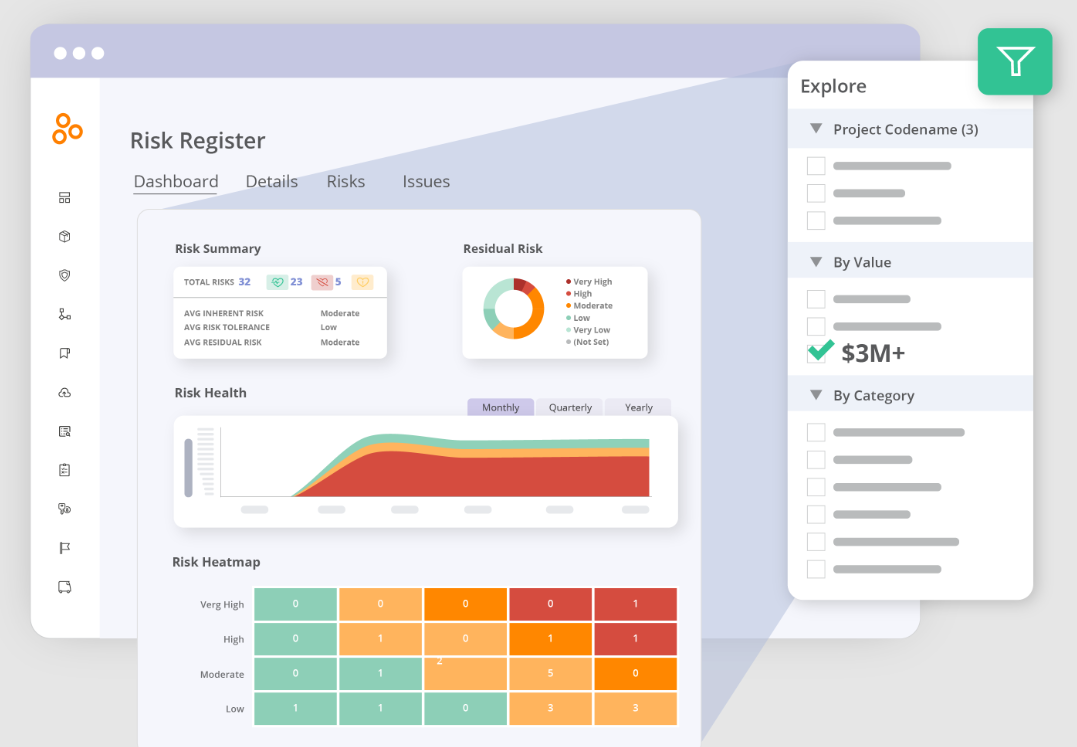
- Automated evidence collection - Hypersync integration pulls data from tools and systems in real-time, reducing manual proof-gathering and keeping documentation always current.
- Centralized compliance workspace - Brings control mapping, audit frameworks, risk registers, and third-party management into a unified platform to eliminate fragmented spreadsheets.
- Real-time monitoring & status tracking - Users benefit from live status updates for audits and proof collection tasks, which help identify bottlenecks or overdue actions instantly.
Pricing
Hyperproof doesn’t disclose its pricing.
You can book a demo and ask for a custom quote, or take a look at our in-depth Hyperproof pricing review, and find all the information you need.

Pros & Cons
✅ Centralizes all controls, frameworks, and evidence in a single platform, making audits more efficient.
✅ Efficient automatic risk and compliance monitoring.
❌ Limited customization options.
9. ZenGRC
Best for: Mid-sized businesses to large enterprises that need a user-friendly, fast-to-deploy GRC platform for streamlined audit management, risk, and vendor assessments, with out-of-the-box compliance frameworks and SaaS delivery.
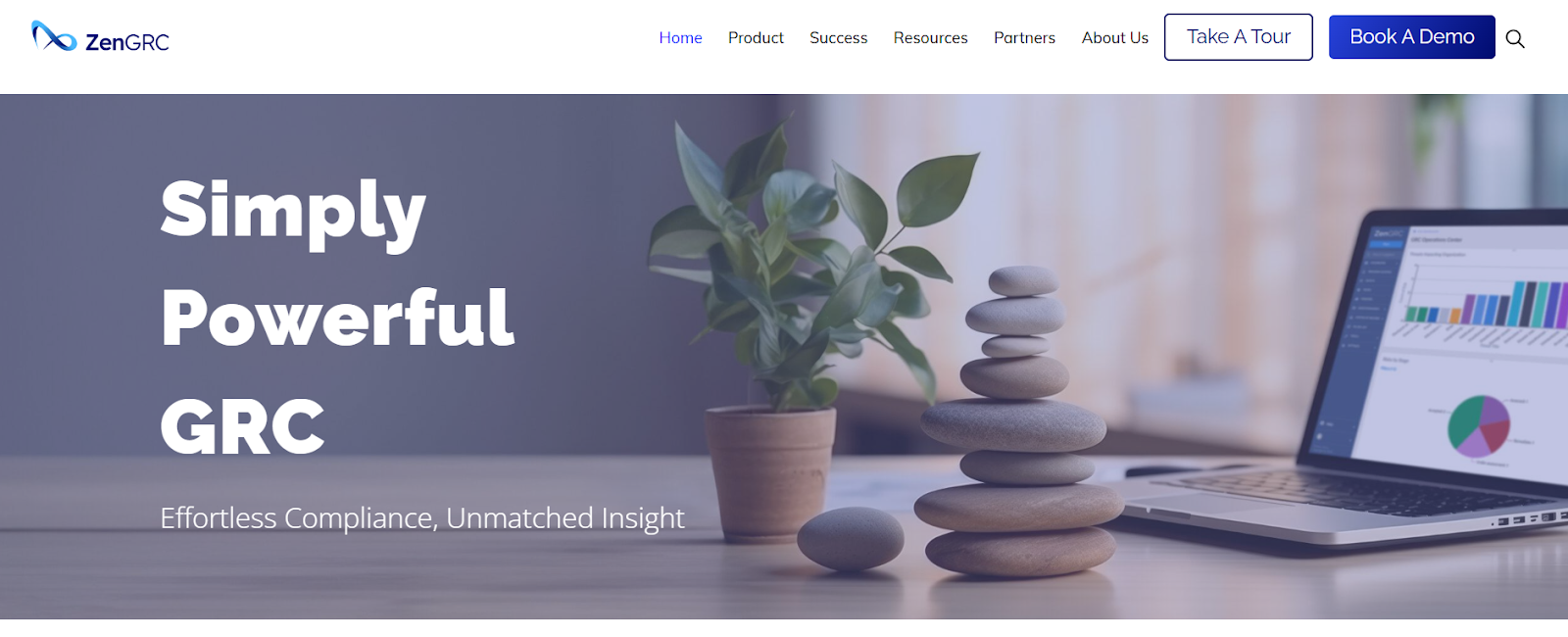
ZenGRC is a cloud-based GRC solution focused on making compliance and risk management simple yet powerful.
It delivers efficient control tracking, audit workflows, vendor risk, and visuals like dashboards and heatmaps, all with minimal implementation effort.
Key features
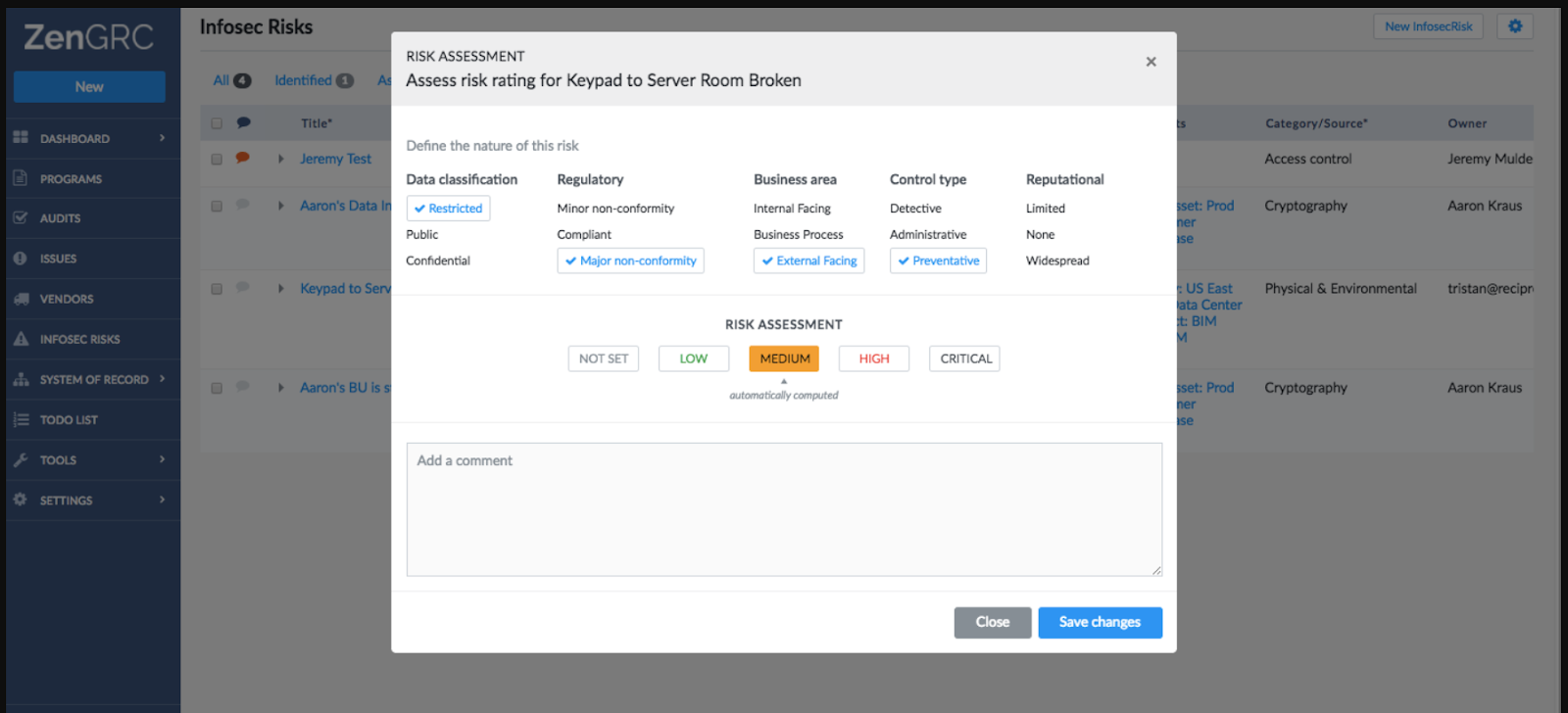
- Integrated risk & vendor dashboard - Built-in risk registers, vendor questionnaires, customizable dashboards, heatmaps, and timeline views for enhanced visibility.
- AI-powered control assessment - Harnesses artificial intelligence to rapidly evaluate control effectiveness and maturity, generating evidence-backed, explainable insights that you can review and approve within your existing compliance workflow
- Pre-loaded framework content - Includes templates and mappings for frameworks like COBIT, COSO, FedRAMP, SOC, and PCI, accelerating setup.
Pricing
While ZenGRC doesn’t disclose its actual price, its website does provide some details regarding its price.
The platform uses an all-inclusive pricing model, meaning that one price unlocks every feature and framework, with no hidden costs or modular add-ons.
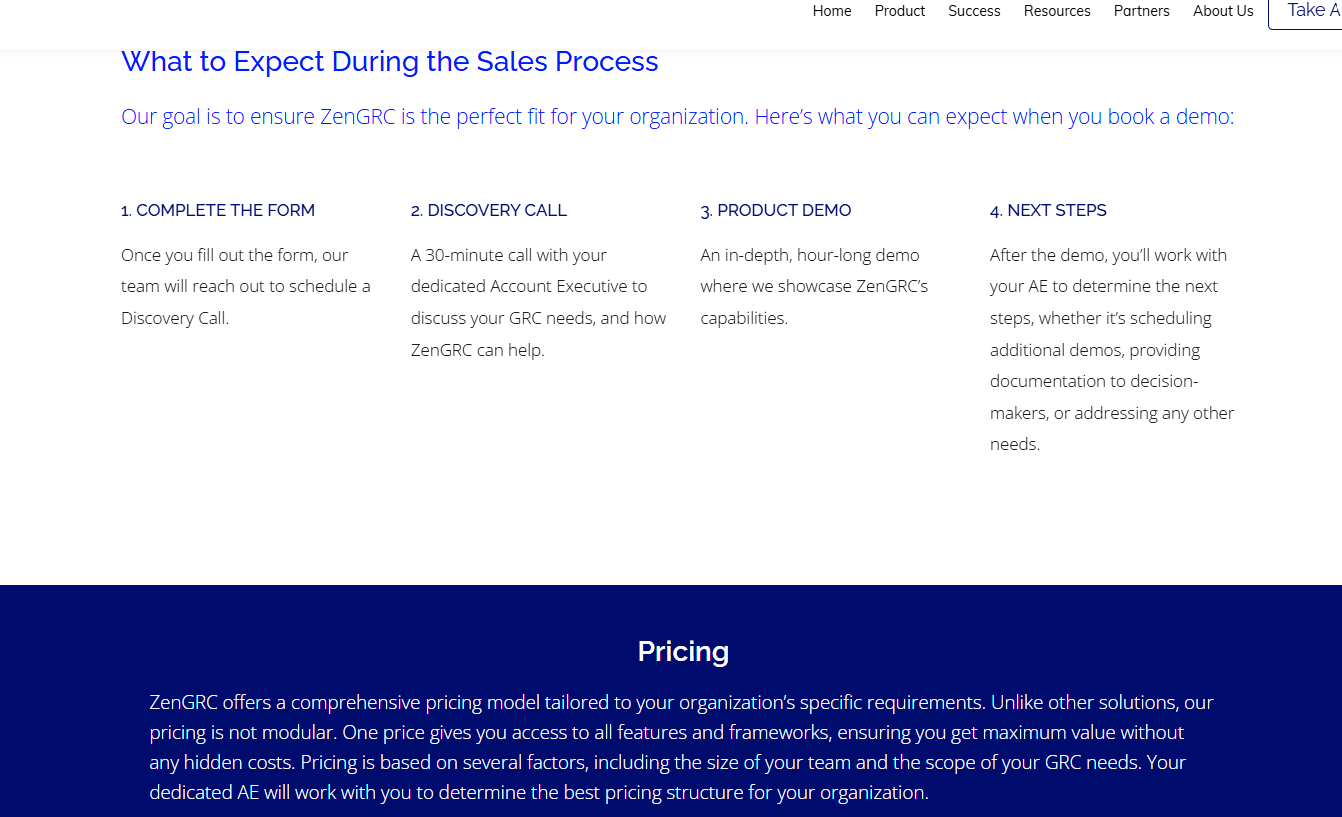
Rates are tailored to your organization’s size, team structure, and GRC requirements.
For a more detailed take on ZenGRC’s pricing, check out our in-depth pricing guide.
Pros & Cons
✅ Powerful automation features.
✅ User-friendly and customizable.
❌ Lack of advanced reporting and analytics.
10. Resolver
Best for: Mid-sized to large organizations seeking a risk intelligence platform that unifies incident management, risk, compliance, and audit workflows with intuitive configuration and real-time tracking.
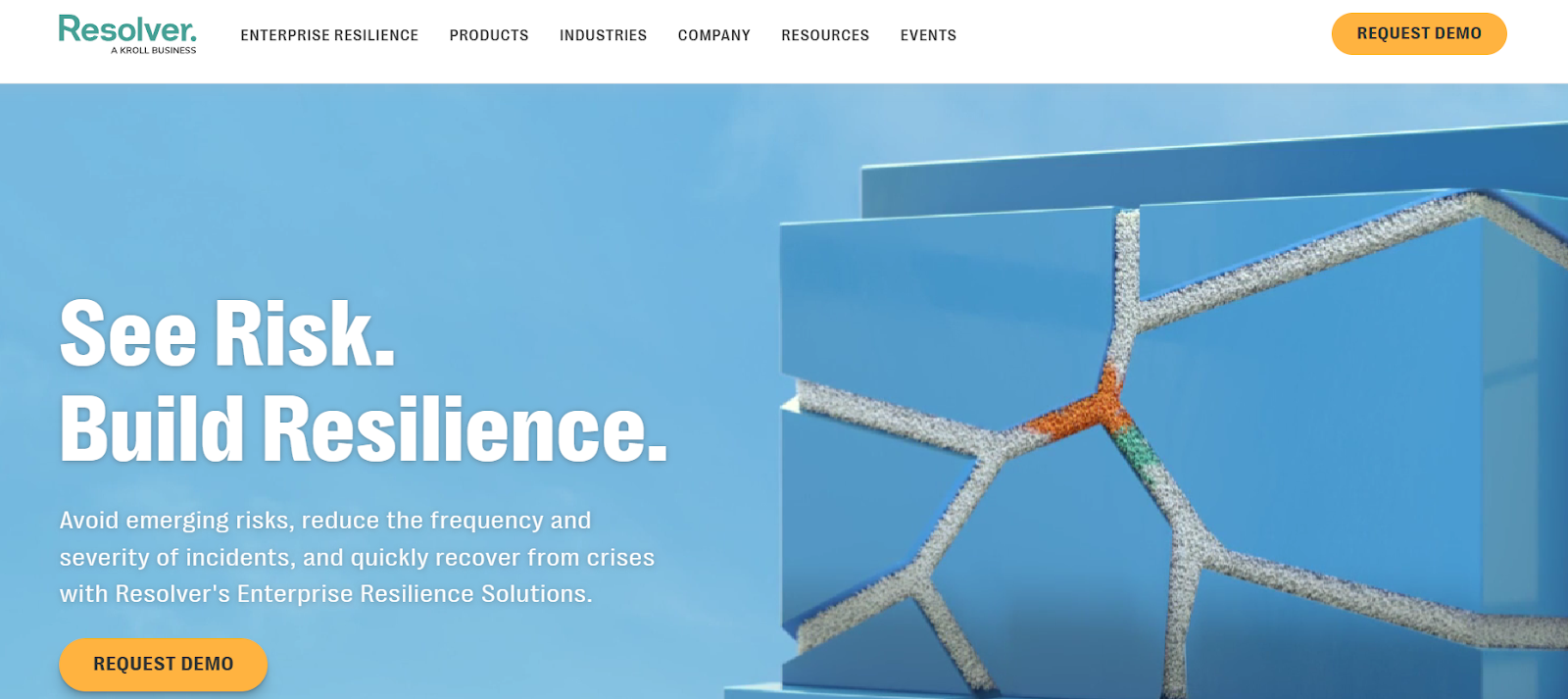
Resolver transforms traditional risk management into actionable risk intelligence by linking incidents, trends, and control data to business insights.
As a result, teams are enabled to detect, respond, and report more effectively across the organization.
Key features
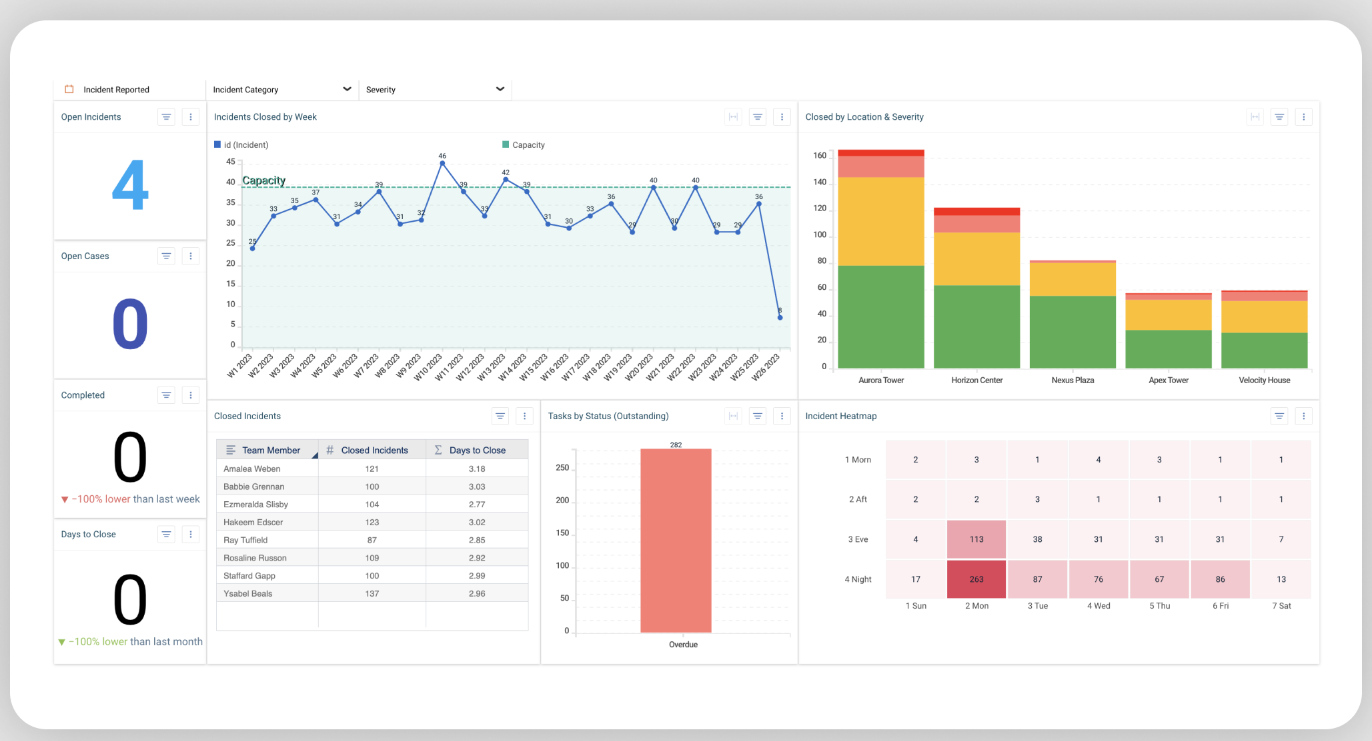
- Customizable dashboards and reporting - Lets you tailor visual insights with configurable templates, heatmaps, risk scoring, and data visualization tools.
- Role-based access and secure workflows - Manage user permissions, workflows, document control, and regulatory reporting with built-in governance features.
- Incident and vendor lifecycle management - Intuitive workflows for intake, escalation, evidence capture, and resolution.
Pricing
Resolver doesn’t have fixed subscription fees.
Instead, it offers a flexible, tailored pricing model designed so you only pay for what you need.
The final price will depend on:
- The core modules and additional bundle solutions you select.
- Your desired level of customization.
- The number of active users managing risk programs.
You can contact its sales team to get a closer idea of how much it would cost your organization.
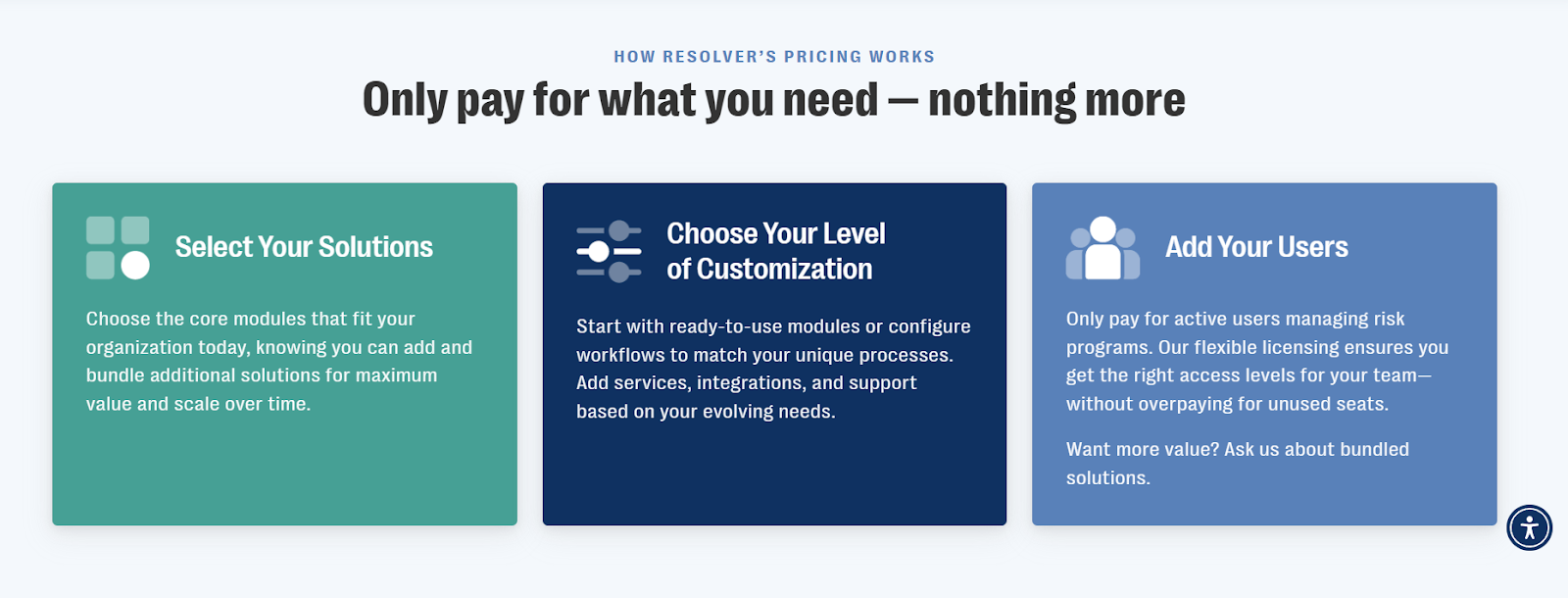
Pros & Cons
✅ Comprehensive real-time risk tracking.
✅ Highly customizable no-code interface.
❌ Complex implementation process, requiring lots of time and resources.
Choosing the right SAP GRC alternative in 2026
In 2026, GRC leaders no longer have to choose between heavyweight but rigid platforms and lightweight tools that can’t scale.
The market now offers flexible, modern, and highly specialized alternatives - whether your priority is no-code customization, deep audit automation, AI governance, or security compliance at speed.
SmartSuite rises to the top for organizations that want an all-in-one, adaptable platform without high costs and complexity.
It brings every core GRC workflow under one roof, streamlines collaboration, and keeps teams audit-ready without the complexity, steep learning curve, or hidden costs of legacy solutions.
So, if you’re ready to modernize your governance, risk, and compliance program with a platform that grows with you, SmartSuite delivers the agility, usability, and power you need.
Start your free trial today and see how SmartSuite can replace the complexity of SAP GRC with a single, intuitive platform.
Read more
- 10 Best Riskonnect Alternatives For GRC In 2026 - Discover the top Riskonnect competitors that deliver flexible, modern governance, risk, and compliance tools for every budget and business size.
- ServiceNow Pricing: Is It Worth It [2026] - Get the latest breakdown of ServiceNow’s pricing, plans, and value to see if it’s the right fit for your organization in 2026.
- 10 Best Drata Alternatives & Competitors In 2026 [Reviewed] - Explore the best Drata alternatives for automated compliance, security frameworks, and audit readiness without the high price tag.
- SAI360 Pricing: Is It Worth It In 2026? - See how SAI360’s pricing stacks up in 2026 and whether its features justify the investment for your GRC needs.
- 10 Best SolarWinds Alternatives & Competitors In 2026 - Find the top SolarWinds alternatives offering smarter monitoring, better integrations, and more transparent pricing.
- 10 Best LogicManager Alternatives for GRC in 2026 - Compare the leading LogicManager competitors delivering intuitive, customizable, and cost-effective GRC solutions this year.

Run your entire business on a single platform and stop paying for dozens of apps
- Manage Your Workflows on a Single Platform
- Empower Team Collaboration
- Trusted by 5,000+ Businesses Worldwide















